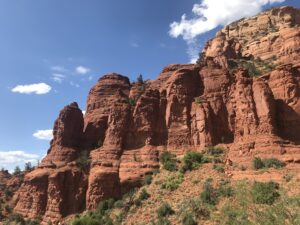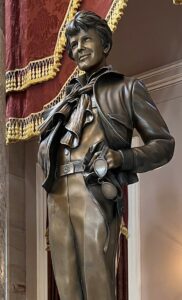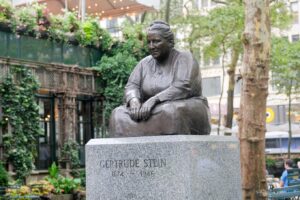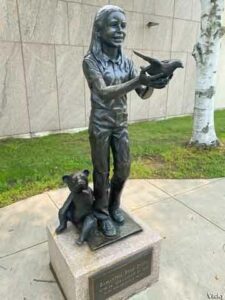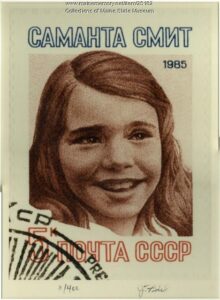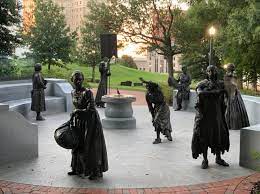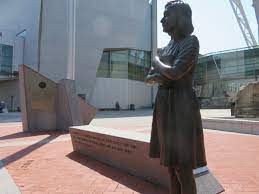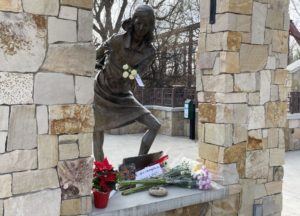
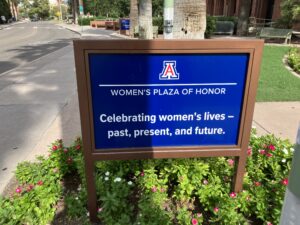
WOMEN’S PLAZA OF HONOR @ The University of Arizona/Tucson
Celebrating Women’s Lives- Past, Present and Future
Wherever I travel I’m on the lookout for monuments of the matriarchy; and my recent trip to Tucson and Sedona turned out to be quite productive (see September’s entry). I was pleased to find that smack in the middle of downtown Tucson, on the campus of UA, near the Gender Studies Program, sits the Women’s Plaza of Honor dedicated to the Women of Arizona whose contributions to society have made a difference, not just to the southwest, but to the world at large. I felt like I’d hit the statue lottery.
The plaza consists of six wings or arches that highlight a variety of accomplished women: Inspirational Women; Women of the 1540 Cibola Journey, African American Women, Southern Arizona women, Women Activists, and Women Lawyers. Who are these women and what have they done to get their name chiseled in granite to be memorialized in perpetuity? For the most part, they’re ordinary women who when faced with the complexities and injustices of life used creative outlets to become extraordinary. While hundreds of women, are represented by having their name engraved on the monument, I’ll briefly highlight five: Margaret Sanger, Sandra Day O’Connor, Women of the 1540 Cibola Journey (as well as other indigenous women of color), African women from the Chapter of the Links and my niece, an art therapist with creativity and empathy to spare.
Margaret Sanger, born in 1879, a time when women were second class citizens, was instrumental in taking women’s rights into the next century. After working as a nurse, she became a birth control activist and sex educator writer. Tirelessly advocating for women, she later formed Planned Parenthood, an organization that to this day, delivers vital reproductive health care, sex education, and information to millions of people worldwide. Unfortunately, Ms. Sanger passed away a year before birth control— for all women – was legalized. She proclaimed, “No woman can herself be free who does not control her own body.”
Sandra Day O’Connor, born in 1930, died at the age of 93. Intelligent and perseverant, she became the first woman to serve on the Supreme Court of the United States. Politically conservative, she still worked against discrimination of women, something she most certainly encountered in her lifetime.
African American women of Arizona such as Dr. Doris Ford, Etta Mae Dawson and Tommie Thompson were instrumental in securing scholarships for women of African American ancestry through the Tucson Chapter of the Links. Each woman, a champion in her own right, not only faced adversity but persevered. Strong, fierce and tenacious are their adverbs. Check out their names as well as many others chiseled on the arch.
The Women of the Cibola Journey, who accompanied the Spanish explorer Francisco Vázquez de Coronado on the search for the mythic empire of riches known as the Seven Golden Cities of Cibola, found themselves in an epic fight for their lives. As the story goes, the myth supposedly created by the Zuni Pueblo tribes living near the border between Mexico and Arizona, was a lie, created to throw off the “savage explorers” who rampaged, raped and pillaged their way through the southwest, wreaking havoc wherever they went. This ill-fated group of Spanish explorers, however, are credited with the first sightings of the Grand Canyon and the Colorado River. Throughout their two-year trek, numerous indigenous people, most of them women, were taken against their will to serve as free labor and entertainment. Despite all efforts, the golden cites were never located. I’ve not heard about this wild journey before but it brought tears to my eyes. I’m glad Arizona honors these women by making their story known. Women are not property, to be dragged along, kicking and screaming.
The Inspirational Women of Arizona arch was my favorite. It’s a place where any woman with ties to Arizona, past, present or future, can be memorialized for their accomplishments. Like my niece (she’s not engraved on the arch, but I’m optimistic). Perhaps you can nominate yourself. New names are added yearly. All you have to do is achieve, succeed and make noise. As the saying goes, “well-behaved women rarely make history.”
The Women’s Plaza of Honor is a special place to relax, contemplate, meditate or just bask in the sun. We need more of these group memorials where everyone can honor, remember and revere these brave women who not only shattered the glass ceiling but created a spot where ceilings will never hold anyone back again.
Women rock! Today, tomorrow and yesterday. Next time you travel, do what I do. Find statues of extraordinary women and bask in the glow of their brilliance. They will inspire you, as they do me.

